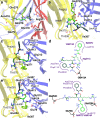Mutations in the palm domain disrupt modulation of acid-sensing ion channel 1a currents by neuropeptides
- PMID: 30796301
- PMCID: PMC6385203
- DOI: 10.1038/s41598-018-37426-5
Mutations in the palm domain disrupt modulation of acid-sensing ion channel 1a currents by neuropeptides
Abstract
Modulation by neuropeptides enhances several functions of acid-sensing ion channels (ASICs), such as pain sensation and acid-induced neuronal injury. The acid-induced opening of ASICs is transient, because of a rapid desensitization. Neuropeptides containing an Arg-Phe-amide motif affect ASIC desensitization and allow continuous activity of ASICs. In spite of the importance of the sustained ASIC activity during prolonged acidification, the molecular mechanisms of ASIC modulation by neuropeptides is only poorly understood. To identify the FRRFa (Phe-Arg-Arg-Phe-amide) binding site on ASIC1a, we carried out an in silico docking analysis and verified functionally the docking predictions. The docking experiments indicated three possible binding pockets, located (1) in the acidic pocket between the thumb, finger, β-ball and palm domains, (2) in a pocket at the bottom of the thumb domain, and (3) in the central vestibule along with the connected side cavities. Functional measurements of mutant ASIC1a confirmed the importance of residues of the lower palm, which encloses the central vestibule and its side cavities, for the FRRFa effects. The combined docking and functional experiments strongly suggest that FRRFa binds to the central vestibule and its side cavities to change ASIC desensitization.
Conflict of interest statement
The authors declare no competing interests.
Figures






Similar articles
-
The Thumb Domain Mediates Acid-sensing Ion Channel Desensitization.J Biol Chem. 2016 May 20;291(21):11407-19. doi: 10.1074/jbc.M115.702316. Epub 2016 Mar 25. J Biol Chem. 2016. PMID: 27015804 Free PMC article.
-
Conformational changes in the lower palm domain of ASIC1a contribute to desensitization and RFamide modulation.PLoS One. 2013 Aug 14;8(8):e71733. doi: 10.1371/journal.pone.0071733. eCollection 2013. PLoS One. 2013. PMID: 23977127 Free PMC article.
-
Binding site and inhibitory mechanism of the mambalgin-2 pain-relieving peptide on acid-sensing ion channel 1a.J Biol Chem. 2014 May 9;289(19):13363-73. doi: 10.1074/jbc.M114.561076. Epub 2014 Apr 2. J Biol Chem. 2014. PMID: 24695733 Free PMC article.
-
ASICs and neuropeptides.Neuropharmacology. 2015 Jul;94:36-41. doi: 10.1016/j.neuropharm.2014.12.012. Epub 2015 Jan 12. Neuropharmacology. 2015. PMID: 25592215 Free PMC article. Review.
-
Biophysical properties of acid-sensing ion channels (ASICs).Neuropharmacology. 2015 Jul;94:9-18. doi: 10.1016/j.neuropharm.2014.12.016. Epub 2015 Jan 10. Neuropharmacology. 2015. PMID: 25585135 Review.
Cited by
-
Structural basis for excitatory neuropeptide signaling.Nat Struct Mol Biol. 2024 Apr;31(4):717-726. doi: 10.1038/s41594-023-01198-y. Epub 2024 Feb 9. Nat Struct Mol Biol. 2024. PMID: 38337033 Free PMC article.
-
Aromatic amino acids in the finger domain of the FMRFamide-gated Na channel are involved in the FMRFamide recognition and the activation.Pflugers Arch. 2023 Aug;475(8):975-993. doi: 10.1007/s00424-023-02817-9. Epub 2023 Jun 8. Pflugers Arch. 2023. PMID: 37289212
-
Comparative analysis defines a broader FMRFamide-gated sodium channel family and determinants of neuropeptide sensitivity.J Biol Chem. 2022 Jul;298(7):102086. doi: 10.1016/j.jbc.2022.102086. Epub 2022 May 27. J Biol Chem. 2022. PMID: 35636513 Free PMC article.
-
Flipped binding modes for the same agonist in closely related neuropeptide-gated ion channels.Biophys J. 2025 Apr 1;124(7):1049-1057. doi: 10.1016/j.bpj.2025.01.004. Epub 2025 Jan 11. Biophys J. 2025. PMID: 39801005 Free PMC article.
-
A Na+ leak channel cloned from Trichoplax adhaerens extends extracellular pH and Ca2+ sensing for the DEG/ENaC family close to the base of Metazoa.J Biol Chem. 2019 Nov 1;294(44):16320-16336. doi: 10.1074/jbc.RA119.010542. Epub 2019 Sep 15. J Biol Chem. 2019. PMID: 31527080 Free PMC article.
References
Publication types
MeSH terms
Substances
Grants and funding
LinkOut - more resources
Full Text Sources

